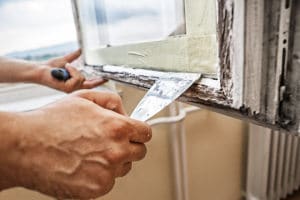Get a Fresh Start with Updated Shingles, Shutters, and Seawalls
The new year is a time when you resolve to improve yourself in all sorts of ways—you want to become healthier, more productive, kinder, whatever it might be. What about improving your home, though? January also marks the approach of spring, when you’ll finally be able to go out and work on your home. What will you fix up? Your seawalls? Window treatments? Siding?
Since the tradition is to list out the year’s resolutions at the beginning, it’s a good idea to already be thinking of home renovation goals you want to set for yourself for the year. Here are just a few suggestions for what you can accomplish in 2017.
1. Weatherize Your Home
Since you’re currently getting through the last days of winter, you’re probably very aware of the amount of money you’ve been paying into your 
Weatherizing consists of several areas. First, you should use caulk to seal the outside edges of windows and doors, as well as any exterior openings including electrical outlets, dryer vents, and pipes. Then move to window interiors, where you should apply new glaze to the edges of the glass, install new foam weatherstripping if you have double-hung windows, and consider investing in window film and heavy drapes or curtains. Doors require similar attention, with caulk on the outside of the door casing, glazing and caulk around window panes, and weatherstripping in the doorjamb.
There are other ways to weatherize as well, including in the attic or around fireplaces. The point is to eliminate drafts, so that there’s less heat exchange with the outside. If you take the time now to plan and complete these renovations, you’ll see a drop in your energy bills both this year and in the years to come.
2. Replace Parts of the Exterior
Since resolutions are a time to pause and reflect on things that get lost in the shuffle or thrown on the backburner during the year, this is a good time to think about those renovation projects that rarely cross your mind. Namely, you should ask yourself questions like, “when was the last time I had my shingles replaced? How often should I be replacing my windows? Is it time to replace the siding yet?”
While it’s good to take a tour around the outside of your home in search of things that need fixing, your naked eye may not reveal when something should be replaced if it doesn’t necessarily look “broken”. Think back to how long ago your shingles, windows, siding, and other elements of your home were installed, and then research how often those things should be updated.
Even if they aren’t broken, it’s likely that you can save money by replacing them with newer models. Windows today have more energy-efficient designs than the ones installed years ago, and shingles and siding made from new kinds of materials offer superior durability and energy efficiency as well. Resolving to install the new versions of these parts of your home will not only beautify your home, but also reduce your bills in the long run.
3. Update Safety Measures
While many home renovation projects are focused on increasing property value or comfort, you should also seriously consider the projects you may need to tackle in order to ensure the safety of your home. Resolve to address at least one of these per month so that you have a constant cycle of verifying and improving safety.
You can start with dangerous gasses. Install carbon monoxide detectors, and spend the $20 on a radon testing kit. One in fifteen homes has elevated levels of this colorless and odorless gas which causes about 21,000 lung cancer deaths per year. You’ll also want to make sure your bathroom is well-ventilated, to prevent mold growth.
Next, do everything you can to improve the fire safety of your home. Clean the lint out of the vents and ducts behind your dryer, maintain your smoke alarms and furnace, and check your power outlets and wiring for potential causes of electrical fires.
These may not be the first things that come to mind when you’re thinking of what projects you’ll complete in the spring, or the most fun ones, but they certainly are the most important, as they’ll safeguard your health and personal safety.
4. Install or Repair Seawalls
If you own waterfront property, the last thing you want is for flooding to cause water damage during a big storm, or for your shoreline to gradually erode away and leave you with less land. Installing and maintaining well-built seawalls is key to preventing these things from happening, as seawalls protect your shoreline from both excessive boat waking and adverse weather conditions.
Seawalls come in several varieties, including steel seawalls as well as outcropping or rip rap. The latter two kinds are seawalls made of stones, and they integrate more naturally with a natural aesthetic.
Regardless of which type of seawalls you decide on though, they also need to be maintained, and spring is an especially important time for that. Winter can potentially damage seawalls, with ice floes knocking and scraping against them and extreme cold potentially making building materials crack or buckle. That’s why spring is a good time not just for installing seawalls, but for repairing them if you already have them.
This isn’t a DIY project, though. Seawalls are complex structures that require planning and expertise to design, install, and maintain properly. You’ll save yourself time, money, and effort by getting professional help. Seawalls Unlimited has been building and servicing seawalls in McHenry for over five years, and our team of experienced seawall technicians delivers quality service every time. Just give us a call at (815) 331-8830, and start the year off right with the peace of mind that seawalls provide.
Seawalls Unlimited
2350 W. Rte. 120
McHenry, IL 60051
(815) 331-8830
